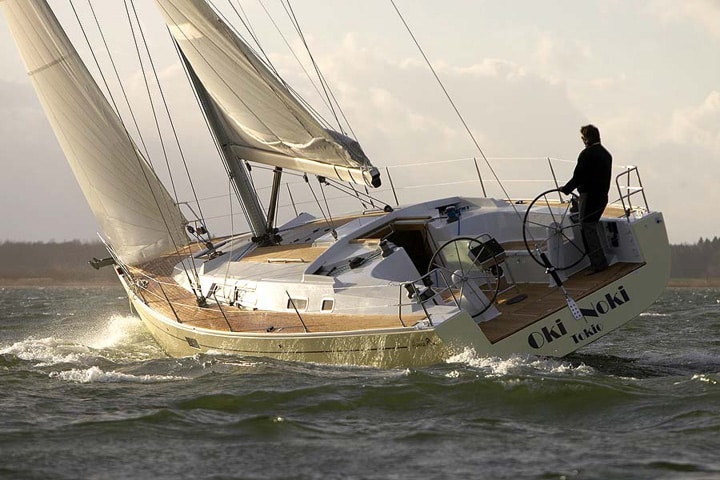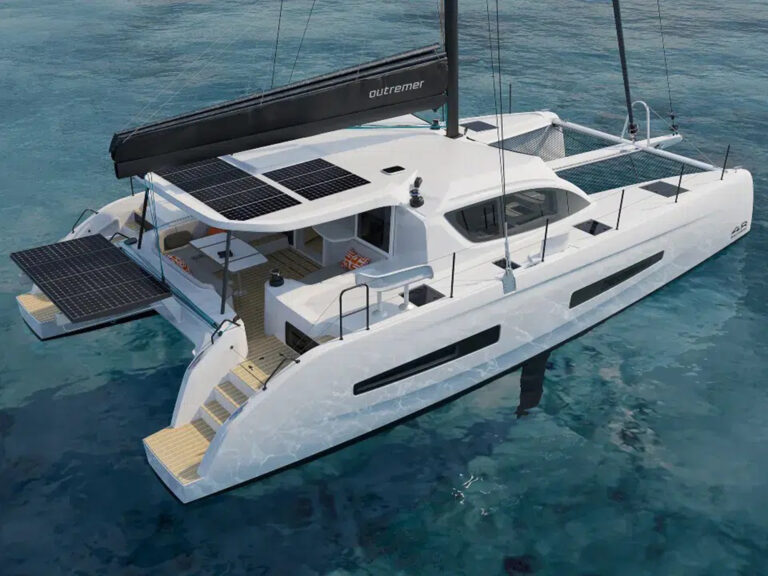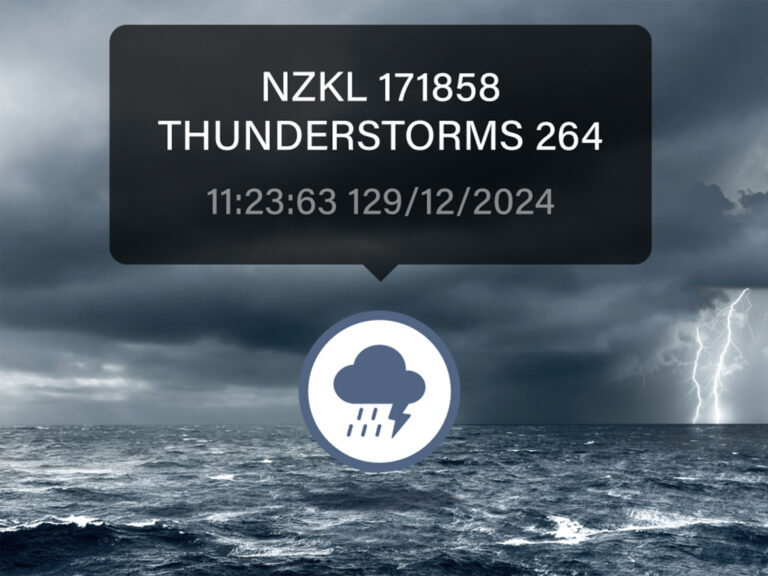
From its open transom to the thoroughly modern split pulpit and recessed furler on the bow, the new Hanse 430e looks ready to go sailing. And it is. In about 14 knots of wind and lumpy seas off Miami Beach, Florida, last February, the boat loped along closehauled at just about 8 knots. Each tack took only a turn of the wheel, thanks to the self-tending 96-percent jib, and once through the wind, the boat quickly settled in and came back up to speed.
The 430e joins a line of performance cruisers ranging from 32 to 63 feet. Its lines come from the drawing boards of Judel/Vrolijk & Co. and reflect the racing background and ideas of Hanse’s founder, Michael Schmidt. On this boat, that means a wide-open stern, with just two lifelines across the transom. With the twin wheels set fairly far aft, if you want to sit, you do so on either rail, and from either perch the visibility is excellent. While sitting to leeward was fine, I’d suggest adding a foot brace for steering from the high side.
Forward of the wheels, the cockpit’s designed to seat a crowd around an acrylic drop-leaf table that’s fixed in place. Teak on the cockpit sole and seat lockers comes standard. The boat can be purchased with two interior options: One’s a three-cabin layout; the other has the starboard aft cabin left unfinished for storage or a workshop. This space can be entered through the saloon or the well-gasketed starboard-side seat locker.
Broad side decks and standing rigging that terminates inboard make for easy access forward, and there’s excellent traction, thanks to the molded-in nonskid. Darkened, flush-mounted Lexan hatches dominate the centerline of the coach roof and are bordered by teak panels that also provide sound footing. Handrails that stop well before the mast are mounted on either side on the cabin top; they’d make handy places to lash down gear, although they’re too short to give one a sense of absolute security on deck. A deep anchor locker and Lewmar windlass are just aft of the Facnor headsail furler. The anchor roller comes with a bale for deploying an asymmetric.
The 430e is designed around a 9/10ths rig with two spreaders and a full-battened main. All sail-control lines, including both sheets, lead aft, through a covered channel, to line stoppers and a pair of winches on either side of the companionway. The boat we sailed had an electric winch to starboard that made hoisting the main a snap. Under way, however, I found it helpful to have another set of hands to trim the sails, since it was some distance from the wheels to the winches. Using the autopilot when you go forward to adjust trim would be an option, of course. And in addition to those on the cabin top, winches also sit just forward of each wheel for the optional 105-percent genoa and the 140-percent gennaker, so I believe that sheets could be rerouted if one were singlehanding the boat. And speaking of sails, I’d definitely spend the money for the optional ones to improve performance off the wind. On a run back toward the Port of Miami, it didn’t take long before we resorted to the engine.
Below, I liked the contrast between the deep red upholstery and the light cherry woodwork. That, coupled with 10 opening ports and three opening hatches, creates an airy interior space. In port, the saloon would lend itself to entertaining guests, while under way, the furniture and surroundings provide crew with ample handholds.
I also liked the idea of the workshop and storage space available in this particular layout, and I found that the aft and forward cabins would easily accommodate a couple and friends for a getaway or a longer voyage.
In the galley, fiddles and stainless-steel rails wrap around the stone countertop and its centerline stainless-steel double sinks. Equipment includes a two-burner propane stove and oven and an Isotherm front- and top-loading fridge.
The dining table with U-shaped seating is immediately forward of the galley. To port, two chairs and a small table/nav desk create a second seating area. An electrical panel, radio, and plotter are located in a cabinet outboard of the aft seat.
The “e” in the 430e denotes that this boat has the upgraded vacuum-bagged epoxy hull built of sandwiched E-Glass and Core-Cell foam that’s standard on the larger Hanse models. This adds about $14,000 to the price. The deck is a sandwich of glass and end-grain balsa core that’s bonded chemically and with fasteners to the hull. Interior ring bulkheads are laminated in place. Two keels are available: a 7-foot-3-inch foil and a 5-foot-11-inch shoal-draft model; iron is standard, but composite iron-and-lead keels are options in both versions.
A 40-horsepower Yanmar engine and saildrive should be adequate power. Unfortunately, the boat we sailed had mechanical problems, so it was hard to gauge performance while motoring. For longer passages, I’d recommend augmenting the standard 58-gallon fuel tank with additional capacity.
The U.S. East Coast sailaway price for the 430e is $311,000, but outfitted with air-conditioning, extensive electronics, and other options, the boat we sailed would go for $365,000. For a sailor looking for performance and an easy-to-handle rig, this latest offering from Germany has a lot to recommend it. And while the 430e perhaps isn’t for the traditionalist, I found myself nodding approvingly at the boat’s modern good looks.
Mark Pillsbury is Cruising World’s senior editor.








